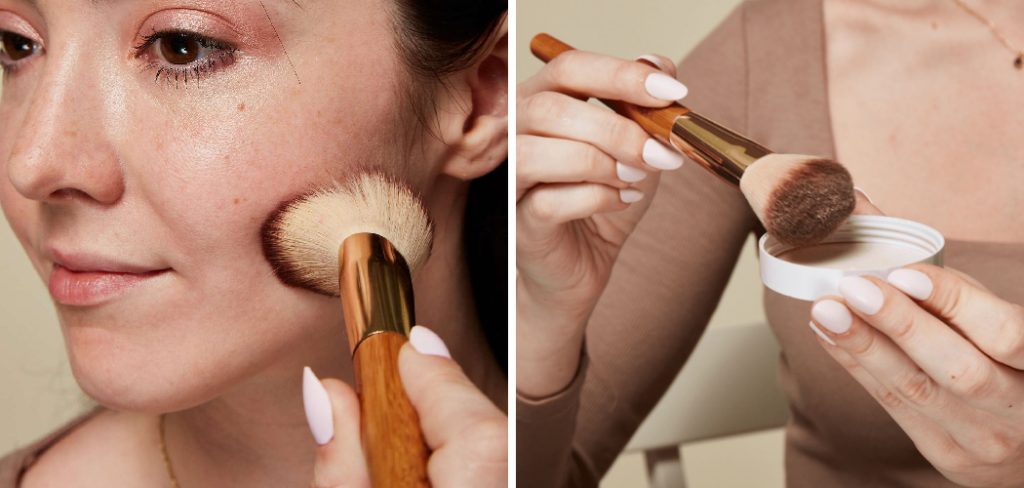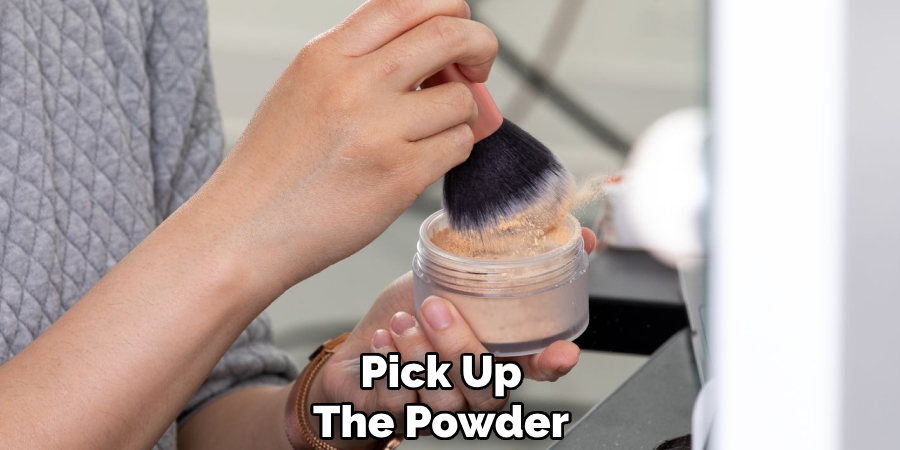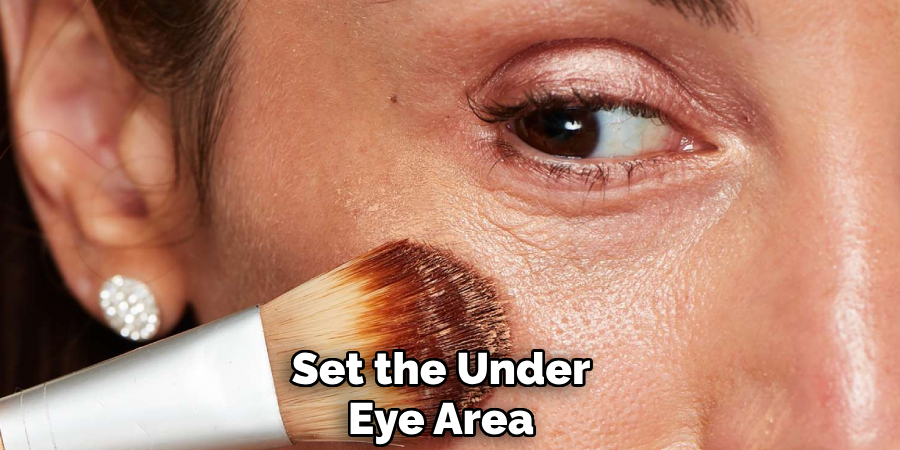Are you tired of your makeup’s cakey and creased appearance by midday? Using setting powder with a brush can solve this problem. Not only does it set your makeup in place, but it also helps control shine and keeps your skin looking flawless all day long.

How to apply setting powder with brush is an essential step in achieving a flawless, long-lasting makeup look. Setting powder helps lock in your foundation and concealer, reducing shine and keeping your makeup in place throughout the day. Using a brush for application ensures even coverage and a natural finish.
With the right technique and tools, a powder makeup tutorial can enhance your makeup’s longevity and provide a smooth, polished appearance. Here’s a simple guide to help you master this technique.
What Are the Benefits of Using Setting Powder?
There are several benefits to using setting powder in your makeup routine. Here are a few reasons why you should consider incorporating it into your daily beauty regimen:
- Controls Shine: Setting powder helps absorb excess oils on the skin, reducing unwanted shine and giving you a matte finish.
- Increases Longevity: Setting your foundation and concealer with powder can help them last longer throughout the day, preventing creasing or fading.
- Smooths Out Texture: Setting powder can help blur fine lines, wrinkles, and pores, creating a smooth canvas for your other makeup products.
- Provides a Natural Finish: When applied correctly, setting powder can give your makeup a natural-looking finish, making it appear more seamless.
- Additional Uses: Setting powder can also be used for touch-ups throughout the day to absorb excess oil and keep your makeup looking fresh, or as a base for eyeshadow to help it adhere better and prevent creasing.
What Will You Need?
- Setting Powder of Your Choice: Many different types of setting powders are available, including loose and pressed powders, as well as tinted and translucent options. Consider your skin type and preferences when choosing the best setting powder for you.
- Powder Brush or Makeup Sponge: A powder brush is typically used for applying loose setting powder, while a makeup sponge can be used with pressed powders for more precise application.
- Makeup Primer: Some people like to use a makeup primer before applying their setting powder to create an even smoother base for their makeup. It can also help control oil and prolong the wear of their makeup.
10 Easy Steps on How to Apply Setting Powder With Brush
Step 1. Prepare Your Skin:
Before applying setting powder, creating a smooth and hydrated canvas is essential. Start by cleansing your face thoroughly to remove dirt, oil, or leftover makeup from your skin. Follow up with a good moisturizer suited to your skin type to keep your skin hydrated and prevent the powder from clinging to dry patches.

If desired, apply a makeup primer next to create a flawless base, minimize the appearance of pores, and help your makeup last longer. Allow the primer to set for a minute or two before moving on to the next step. Preparing your skin properly is crucial for achieving a seamless and natural finish.
Step 2. Choose the Right Brush:
Selecting the right brush is essential for smooth and even application. The type of brush you choose will depend on the product you are using. Opt for a fluffy, soft-bristled brush for light and buildable coverage for powder-based products such as setting powders or blushes. For liquid or cream foundations, a dense, flat-top brush or a kabuki brush is best to blend the product seamlessly into the skin.
When applying contour or bronzer, an angled brush can help create precise lines while allowing for a natural-looking blend. Regularly clean your brushes to ensure proper application and to maintain skin hygiene. Using the correct brush not only simplifies your application process but also enhances the overall finish of your makeup.
Step 3. Pick Up the Powder:
Using the right powder is essential for setting your makeup and creating a flawless, long-lasting finish. To pick up the powder, gently dip a fluffy brush or a puff into the product. Tap off any excess to avoid applying too much at once, creating a cakey look. Swirling the brush in the lid for loose powders helps distribute the product evenly.
Whether setting foundation or targeting specific areas like the T-zone, a light and even application of powder helps control shine and lock your makeup in place.
Step 4. Begin with Key Areas:
Start by applying the powder to the areas of your face that tend to get oily or need extra setting. Focus on the T-zone, which includes the forehead, nose, and chin, as these spots are more prone to shine. Use gentle pressing motions rather than sweeping to ensure the product adheres well to the skin.

Gradually build up the powder in these key areas for a smooth and natural look, then lightly dust over the rest of the face for a cohesive finish.
Step 5. Blend Outward:
Start blending the powder outward from the center of your face towards the edges. Use a soft, fluffy brush to gently diffuse the product, ensuring no harsh lines or uneven patches.
This technique helps create a seamless, airbrushed finish that looks natural and flawless. Pay close attention to the jawline and hairline, ensuring the powder is evenly blended for a polished and consistent look.
Step 6. Set the Under-Eye Area:
Use a smaller, soft brush or a damp makeup sponge to apply a finely milled setting powder under your eyes. Press the powder into the skin to lock in your concealer and prevent creasing throughout the day. Avoid overloading this delicate area with too much product, which can create a cakey appearance. Opt for a translucent or slightly tinted powder that complements your skin tone for a brighter look.
Step 7. Build If Necessary:
If your concealer needs more coverage, carefully build it in thin layers rather than applying a thick amount all at once. Use a small brush or your fingertips to add more product to the areas requiring extra attention, such as blemishes or dark spots. Blend seamlessly into the surrounding makeup to ensure a natural and polished finish. Patience is key to achieving a flawless look without overdoing it.

Step 8. Dust Away Excess Powder:
Once your makeup is set with powder, it’s essential to eliminate any excess that may have settled on your skin. Using a clean, fluffy brush, gently sweep across your face in light, circular motions. Focus on areas like under the eyes and around the nose, where excess powder can accumulate. This step ensures your makeup looks smooth and natural while preventing a cakey appearance.
Step 9. Finish Your Look:
To complete your makeup routine, add those final touches that bring everything together. Apply a setting spray to lock your makeup in place and give it a naturally radiant finish. Then, check for any last adjustments, like refining your eyeliner or adding an extra coat of mascara. Finally, consider adding a touch of highlighter to your cheekbones and the bridge of your nose for a subtle glow. These finishing steps ensure your look is polished, long-lasting, and camera-ready!
Step 10. Touch-Ups As Needed:
It’s natural for makeup to shift or fade throughout the day due to factors like humidity, oil production, or everyday activities. Keep a small touch-up kit with essentials such as blotting papers, pressed powder, and a travel-size lipstick or gloss to refresh your look.
Gently blot away any excess shine, reapply powder to maintain a matte finish, and touch up your lips for a polished appearance. Don’t forget to check your eyeliner or mascara for smudging and correct it with a cotton swab if needed. These quick touch-ups will help your makeup stay flawless and fresh no matter where the day takes you!
By following these tips, you can easily achieve a long-lasting and beautiful makeup look that will have everyone asking for your secret.

5 Things You Should Avoid
- Using Too Much Product
Avoid overloading your brush with setting powder. Excess product can make your face look cakey or overly matte, detracting from a natural finish. Always tap off the excess powder before application.
- Skipping Primer or Foundation
Setting powder works best when applied over a well-prepped base. Skipping primer or neglecting to apply foundation can reduce the powder’s effectiveness and lead to an uneven application.
- Using a Dense Brush
Avoid using dense, stiff brushes to apply setting powder. These can apply too much product in one area, making blending difficult. Opt for a fluffy, soft brush to distribute the powder evenly.
- Applying Powder on Dry or Unmoisturized Skin
Powder clings to dry patches, emphasizing texture and creating a patchy appearance. Ensure your skin is moisturized before applying any makeup, especially if you’re using setting powder.
- Rubbing Instead of Dusting
Rubbing the brush onto your face can disturb your foundation and lead to streaky results. Instead, gently dust the setting powder onto your skin in a light, tapping or sweeping motion for a flawless finish.
Conclusion
How to apply setting powder with brush requires a combination of the right technique and preparation to achieve a smooth, long-lasting finish.
Always start with a properly moisturized base to prevent dryness and uneven texture. Use a fluffy, high-quality brush to lightly dust the powder onto your skin, focusing on areas prone to excess shine, such as the T-zone. Avoid pressing too hard or rubbing the brush, as this could disrupt your foundation.
By adopting these simple steps, you can enhance the longevity of your makeup and maintain a polished, natural look throughout the day.
About the Author
Jane Hubbard is a passionate beauty expert with a wealth of experience in makeup, hair, and overall beauty techniques. After years of working as a hairdresser specialist, she followed her entrepreneurial spirit and started her own consultancy business.
Jane has always been driven by her desire to help others feel confident in their own skin, and she does this by sharing her knowledge, experiences, and practical beauty tips. Through her consultancy, she empowers individuals to embrace their unique beauty, offering tailored guidance that boosts both self-esteem and personal style.
Professional Focus
- Specializes in makeup, hairstyling, and beauty consulting.
- Provides personalized beauty advice, tips, and techniques to help individuals feel confident in their appearance.
- Dedicated to staying up-to-date with the latest industry trends and developments.
- Passionate about creating a comfortable and empowering experience for every client.
Education History
- University of Craft and Design – Bachelor of Fine Arts (BFA) in Woodworking and Furniture Design
- Woodworking Apprenticeships – Extensive hands-on training with skilled craftsmen to refine carpentry and furniture making techniques
- Online Courses & Masterclasses – Continued education in advanced woodworking techniques, design principles, and specialized tools
Expertise:
- Makeup artistry, hairstyling, and beauty consulting.
- Personalized beauty techniques to enhance confidence and self-expression.
- Educating clients on how to maintain their beauty routines at home.
